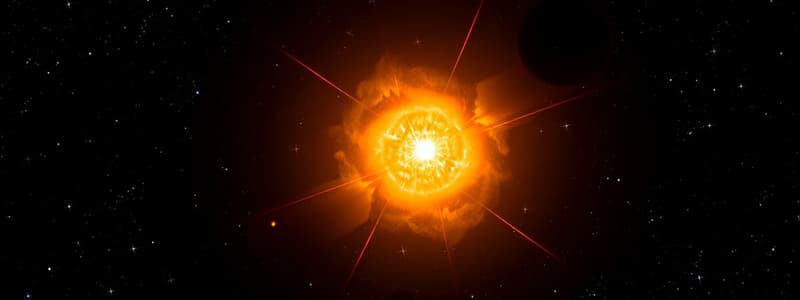Podcast
Questions and Answers
What is the first stage of the stellar evolution process?
What is the first stage of the stellar evolution process?
- White dwarf
- Main sequence star
- Interstellar cloud (correct)
- Newborn star
What occurs during the second stage of stellar evolution?
What occurs during the second stage of stellar evolution?
- Collapsing cloud fragment (correct)
- Planetary nebula
- Protostar forms
- Red giant stage
What signifies the end of the fragmentation stage?
What signifies the end of the fragmentation stage?
- Protostar evolves
- Main sequence star
- Helium fusion
- Fragmentation ends (correct)
When does a protostar form in stellar evolution?
When does a protostar form in stellar evolution?
What happens during the fifth stage of stellar evolution?
What happens during the fifth stage of stellar evolution?
What is a newborn star characterized by?
What is a newborn star characterized by?
What defines a main sequence star?
What defines a main sequence star?
In what stage does a star become a red giant?
In what stage does a star become a red giant?
What happens to a star during the helium fusion stage?
What happens to a star during the helium fusion stage?
What stage occurs after the planetary nebula phase?
What stage occurs after the planetary nebula phase?
What is a black dwarf?
What is a black dwarf?
Flashcards are hidden until you start studying
Study Notes
Stellar Evolution Stages
- 1st Stage: Interstellar cloud, composed of cold atomic and molecular gas. Supports self against gravity until fragmentation occurs.
- 2nd Stage: Collapsing cloud fragment creates a dense region; radiation cannot escape, leading to increased density.
- 3rd Stage: At this point, fragmentation ends, resulting in a denser and cooler core that initiates the protostar formation.
- 4th Stage: Protostar formation occurs as the collapsing fragment's interior becomes massive and dense enough to trap its own radiation, causing temperature increase and continued rotation.
- 5th Stage: Protostar begins to evolve by contracting under gravity, warming up, and dimming. Jets of material are ejected, and a surrounding disk forms.
- 6th Stage: Newborn star emerges once nuclear fusion starts, specifically through the proton-proton chain.
- 7th Stage: The newborn star reaches hydrostatic equilibrium, stabilizing as a main sequence star for billions of years.
- 8th Stage: Transition to subgiant branch, where the star expands becoming larger and brighter, and hydrogen fusion ceases in the core.
- 9th Stage: In the red giant stage, the star grows significantly larger and cooler with hydrogen fusion occurring outside the core, while the core shrinks and heats.
- 10th Stage: Helium fusion begins as the core temperature rises, with hydrogen fusion persisting outside the core; hydrostatic equilibrium is achieved within the core.
- 11th Stage: The star returns to the giant stage, where helium fusion ceases in the core, and continues to fuse hydrogen in a surrounding shell without achieving hydrostatic equilibrium.
- 12th Stage: Formation of a planetary nebula as the outer layers of the red giant are ejected.
- 13th Stage: White dwarf evolution follows the planetary nebula; composed of carbon and oxygen without nuclear fusion, maintaining hydrostatic equilibrium through electron degeneracy.
- 14th Stage: Black dwarf stage occurs when a white dwarf cools and no longer emits significant heat or light.
- 15th Stage Expanded: Interstellar clouds serve as initial star formation sites; when one fragment breaks, multiple smaller fragments arise.
- 16th Stage Expanded: Collapsing cloud fragments become dense as they break off, preventing radiation escape and amplifying density.
- 17th Stage Expanded: Fragmentation ends, leading to the formation of a dense core that becomes a protostar.
- 18th Stage Expanded: In protostar formation, trapping radiation increases temperature and triggers further contraction and rotation.
- 19th Stage Expanded: As a protostar evolves, it reveals jets of material, and its surrounding disk reflects gravitational and thermal dynamics.
- 20th Stage Expanded: The existence of a newborn star is marked by the initiation of nuclear fusion.
- 21st Stage Expanded: A main sequence star achieves stability through hydrostatic equilibrium for an extended period.
- 22nd Stage Expanded: The subgiant branch details transformations including size increase, shift to hydrogen fusion outside the core, and a constricting helium core.
- 23rd Stage Expanded: In the red giant stage, the star grows, with gravity overpowering core pressure as fusion continues outside the core.
- 24th Stage Expanded: During helium fusion, the star shrinks in size while temperature increases, stabilizing when helium fusion ignites.
- 25th Stage Expanded: Returns to the giant stage where helium fusion halts and hydrogen continues in an outer shell.
- 26th Stage Expanded: Planetary nebula formation involves ejection of layers from a red giant.
- 27th Stage Expanded: A white dwarf forms from the residue of a stellar core post-planetary nebula, existing in hydrostatic equilibrium from electron degeneracy pressure.
Studying That Suits You
Use AI to generate personalized quizzes and flashcards to suit your learning preferences.




